Understanding Gravity
Einstein's Revolution on Gravity
- One of the major obstacles with Newton's concept of gravity as a force
is the idea of "action at a distance". I.e. how does the gravitational
force get transmitted over vast distances of the Universe?
- The major breakthrough came from Einstein's Theory of General
Relativity.
- A basic premise is that space is an entity, and not merely a way to
describe where things are in the Universe. This idea leads to the concept
of spacetime, a fundamental property of General Relativity.
- Spacetime is a four dimensional surface. A point has zero dimensions,
a line has one, a plane has two, and a cube has three. Adding time into a
cube provides the fourth dimension.
- Gravity is then thought of as a distortion of spacetime. It is not a
force!
- The curvature of spacetime is difficult to imagine in four dimensions,
so we use the surface of the Earth as a representation. If you were looking
at a map and wanted to fly from NYC to Seatle, you would draw a straight
line on the map. However, the shortest possible route is what we call a
great circle, and this would carry you through Canada.
- In other words, the shortest distance between two points is not a
straight line. This is because space (the surface of Earth) is curved.
- This leads to the concept of the curvature of spacetime and let's
image three different curvatures or geometries.
- a FLAT geometry is what we are used to: here the circumference of a circle is
2 pi r.
- a SPHERICAL geometry is much like using the surface of Earth, and here the
circumference is smaller than in a flat geometry.
- a SADDLE-SHAPPED geometry has a circumference that is larger than that in a flat.
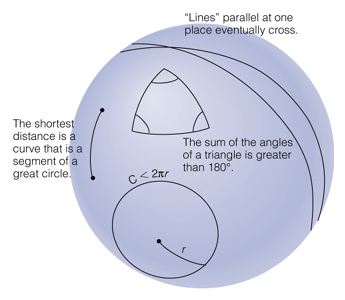
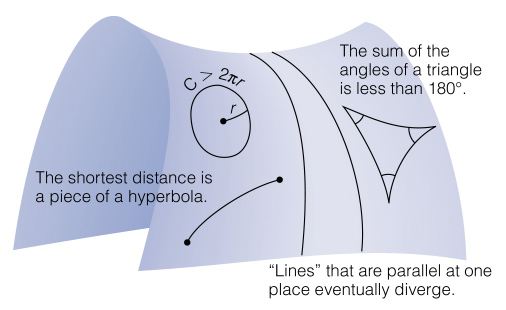
- This realization of the curvature of spacetime solve the problem of having an object
that is far away exert a force on you (the force of gravity). Instead of a force, gravity
is a distortion of spacetime. The rubber sheet analogy helps to demonstrate the
bending of space in two dimensions.
- The two ways to change spacetime are to 1) increase the mass and 2) decrease the
area in which you keep the mass (i.e., increase the density, or compress the object).
Both of these cause the shape of spacetime to become more exaggerated.
- The extreme limit of curved spacetime is a black hole. It has curved spacetime so much,
that it has closed in on itself - thus, nothing can escape from it. The point of no
return for a black hole is called the EVENT HORIZON.
- General Relativity has been experimentally verified to high
precision. The latest important experiment is
Gravity Probe B . GPB was
initiated in 1960, and after many technical, financial and political
hurdles, it was launched in 2004. It has detected the geodetic effect,
which is the curvature of spacetime, to high precision. One of its main
goals, detection of frame dragging, is only marginally detected.
- If mass causes spacetime to curve, then massive bodies that move must
emit gravity waves.
- GRAVITY WAVES: These are ripples in spacetime due to
massive structures that rotate (i.e., binary systems of neutron
stars would do it). Gravity waves are a prediction from Einstein
equations. Taylor and Hulse won the Nobel Prize in 1993 for their
discovery of a pulsar in a binary system. They showed that the
orbit got smaller over time - and it fit perfectly with gravity
waves. Below is some of the data:
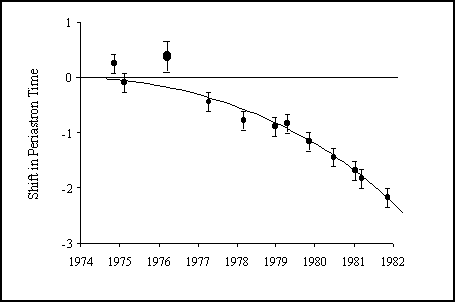
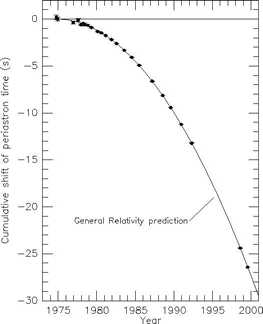
- Below is the idea for the LISA mission:
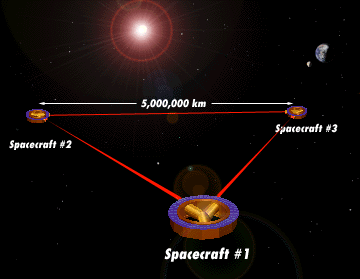
- The other gravity wave detector that is online now is
LIGO (laser
interferometer gravity-wave observatory). LIGO is an L-shaped
vacuum system that covers 4 km. Lasers accurately measure the
distance between mirrors at the ends of the tunnel to about one
part in a trillionth of the diameter of human hair.




